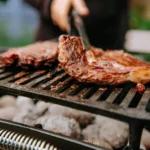The Spanish clay cooking pot, known as a cazuela, is a staple of traditional Spanish cuisine. This versatile earthenware dish has been used for centuries to cook everything from slow-simmered stews to sizzling seafood dishes.
Made from natural, unglazed terracotta, cazuelas retain and distribute heat evenly, enhancing the flavors of food and providing an authentic cooking experience. Whether you’re making paella, fabada asturiana, or a classic garlic shrimp dish, a Spanish clay pot can elevate your culinary skills.
In this guide, we’ll explore the benefits of using a cazuela, how to season and care for it, and the best ways to cook with this traditional cookware.
What is a Spanish Clay Cooking Pot?
A cazuela is a round, shallow, and wide-rimmed clay pot that can be used on stovetops, in ovens, or over an open flame. Traditionally, Spanish clay pots are made from high-quality terracotta, which is a type of porous, heat-resistant clay that allows slow and even cooking.
The inside of the pot is often glazed to make it more durable and easier to clean, while the unglazed bottom helps in absorbing moisture and retaining heat.
These clay pots come in different sizes, from small tapas dishes to large pots suitable for family-style meals. Some cazuelas even have handles, making them easier to transport from the stove to the table, where they also double as serving dishes.
Benefits of Cooking with a Spanish Clay Pot
1. Even Heat Distribution
One of the biggest advantages of using a cazuela is its ability to distribute heat evenly. Unlike metal cookware, which heats up quickly and can create hot spots, clay absorbs heat gradually and spreads it uniformly across the dish.
This makes it ideal for slow cooking, braising, and simmering, as food is cooked gently without burning.
2. Retains Moisture and Enhances Flavors
Clay is naturally porous, which allows moisture to circulate during cooking. This prevents food from drying out and results in tender, juicy dishes. Additionally, clay pots enhance the natural flavors of ingredients, creating a depth of taste that metal or non-stick cookware cannot replicate.
3. Versatility in Cooking Methods
Spanish clay pots can be used in multiple ways: they are safe for use on gas stovetops, in conventional ovens, on grills, and even over open flames. Whether you’re slow-cooking meats, making a seafood paella, or preparing a baked dish, a cazuela can handle it all.
4. Eco-Friendly and Non-Toxic
Unlike some modern non-stick cookware that contains synthetic coatings and chemicals, Spanish clay pots are made from all-natural materials. Cooking in clay eliminates the risk of chemical leaching, making it a safer and more environmentally friendly option.
How to Season a New Spanish Clay Pot
Before using a new cazuela for the first time, it must be seasoned to strengthen the clay and prevent cracking. Follow these steps to properly season your Spanish clay pot:
- Soak the Pot: Completely submerge the cazuela in water and let it soak for 12 to 24 hours. This process helps strengthen the clay and prevents it from absorbing too much liquid during cooking.
- Dry and Coat with Oil: Remove the pot from the water and let it dry completely. Then, rub the inside with a thin layer of olive oil to condition the clay.
- Slow Heating: Place the pot in a cold oven and gradually heat it to 300°F (150°C) for about an hour. This helps bond the oil to the clay, creating a natural protective layer.
- Cool and Store: Let the cazuela cool down completely before using or storing it. Now it’s ready for cooking!
Best Dishes to Cook in a Spanish Clay Pot
1. Spanish Tapas Dishes
Cazuelas are commonly used to prepare and serve tapas, such as Gambas al Ajillo (garlic shrimp) and Patatas Bravas (spicy potatoes). The even heat retention keeps tapas warm for longer, making them perfect for sharing.
2. Stews and Slow-Cooked Meats
Classic Spanish stews like Fabada Asturiana (Asturian bean stew) and Rabo de Toro (oxtail stew) are traditionally cooked in clay pots. The slow heat distribution allows the flavors to develop beautifully over time.
3. Rice and Paella Dishes
While paella is typically cooked in a wide, shallow metal pan, a clay pot version gives the dish a unique, rustic flavor. The clay pot keeps the rice moist while developing a slightly crispy crust at the bottom.
4. Baked Dishes
Cazuelas are perfect for baking dishes such as Cazuela de Fideos (Spanish noodle casserole) and Bacalao al Horno (baked cod). The clay enhances the textures of baked foods, giving them a delicious golden crust while keeping the inside tender.
Caring for Your Spanish Clay Cooking Pot
Proper care and maintenance will ensure that your cazuela lasts for many years.
- Hand Wash Only: Avoid using dishwashers, as the high heat and detergents can damage the clay. Instead, wash your cazuela with warm water and a soft sponge.
- Avoid Sudden Temperature Changes: Do not expose a hot clay pot to cold water, as this can cause cracking. Let it cool down gradually before washing.
- Store in a Dry Place: Make sure the pot is completely dry before storing to prevent mold. If stacking multiple pots, place a paper towel between them to allow airflow.
- Re-season if Necessary: If the pot starts to look dry or develops cracks, repeat the seasoning process to restore its durability.
Conclusion
The Spanish clay cooking pot, or cazuela, is a timeless piece of cookware that brings authenticity and tradition to your kitchen. With its ability to retain heat, enhance flavors, and cook food evenly, it is an invaluable tool for making classic Spanish dishes.
By properly seasoning and caring for your cazuela, you can enjoy delicious, home-cooked meals while preserving the heritage of Spanish culinary traditions. Whether you’re slow-cooking stews, preparing tapas, or baking flavorful dishes, a Spanish clay pot is a must-have for any food enthusiast.















